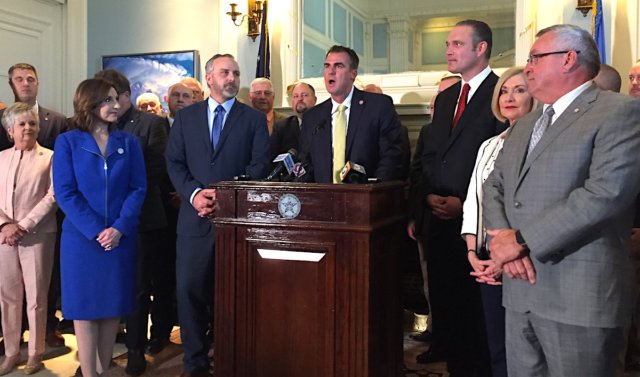
Less than 48 hours after the Oklahoma House and Senate held dueling press conferences, Gov. Kevin Stitt joined leaders of both chambers today to announce a budget deal that includes a $157.5 million increase in common education appropriations and $200 million in savings.
“There will be no new taxes, we will put $200 million back in savings, and we will increase the state’s investment in core services by another 5 percent,” Stitt said while announcing the FY 2020 budget deal. “While we had a little bump in the road earlier this week, we compromised. (…) It’s been a fantastic year.”
After weeks of debate over what requirements to put on new education dollars, the House and Senate compromised on what became known as “Section G,” the language in last year’s teacher pay plan that required all teachers to receive the pay boost no matter what.
Senators emphasized their concern that the roughly 40 school districts “off” of the funding equalization formula received the mandated raise — even if they already paid teachers far above the state’s minimum salary schedule — without any new state appropriations. In the end, the agreement mandates the raise for any district “on” the funding formula. Costing about $77.9 million total, that will equate to a $1,220 raise for about 97 percent of teachers, state leaders said.
“For the first time in state history, our hard-working teachers are going to receive a pay raise for the second year in a row,” Stitt said, with Superintendent of Public Instruction Joy Hofmeister nearby.
Additionally, the state will direct $5.5 million to fully fund the federal Reading Sufficiency Act’s third-grade reading initiative for the first time in Oklahoma history, Stitt said.
Lawmakers said they will also send $74.3 million through the funding formula for uses that will ultimately be determined by local superintendents and school boards. Teachers could receive additional raises that way, or districts could hire more teachers to lower class sizes. They could also make classroom investments or hire mental health professionals and other support staff.
“I’m not even having to feign excitement this year,” Senate President Pro Tempore Greg Treat (R-OKC) said to laughter. “This budget is one that we can all be proud of. It delivers on all of our main objectives. It prioritizes education.”
House Speaker Charles McCall (R-Atoka) agreed, calling the budget forward looking.
“This will give our schools across the state to come up with plans to lower class sizes and address additional needs they have communicated with the Legislature,” McCall said.
The deal features a version of SB 441‘s reform for mandatory school time. The bill has previously mandated a minimum of 1,080 hours and not fewer than 165 days of instruction. Districts will have an additional year to implement, according to lawmakers.
“The additional funding formula dollars will help with implementation of the new calendar rules,” McCall said after Wednesday’s press conference. “Once again, I think the biggest win for us on this is that we are maintaining the focus that we have to stay in the top of the region in teacher pay to address the ongoing teacher shortage in this state.”

Public employee pay raise, LOFT included
After wrangling over the topic Monday, the House, Senate and governor also included $37.7 million for public employee pay raises of up to $1,400. Lawmakers noted that it’s the second straight year they have provided pay increases for teachers and state employees.
“While we are disappointed we didn’t get what we asked for on the salary increase, we are starting to make some progress on state employee pay,” said Sterling Zearley, executive director of the Oklahoma Public Employees Association, after Wednesday’s press conference. “Our ask for next year is that compensation for state employees be a top priority for the governor, the House and the Senate since teachers’ salaries have been brought up to the regional average.”
The budget will also feature a $2-per-hour pay increase (14 percent) for correctional officers and $1 million dedicated to reduce the backlog of Oklahoma’s untested rape kits.
State leaders will also create a Legislative Office for Fiscal Transparency, a priority for Treat and McCall that they say will provide future budget negotiators with better data from and analysis about agency budgets. The LOFT will receive $1.7 million in appropriations to create the office and hire new fiscal staff, about half of which is a one-time startup cost.
Similarly, an additional $700,000 will be appropriated to the State Auditor and Inspector’s Office to hire additional auditors.
Health care components receive funding
While Stitt and the Legislature have not taken steps to expand Medicaid this session, they did announce a series of appropriation increases for health care programs. Details are described from a document distributed to lawmakers and media. They include:
- $62.8 million for graduate medical education programs weighted toward physician training and placement in rural hospitals
- $105 million “reallocation to increase (Medicaid) provider rates for physicians, hospitals and nursing homes
- $29 million “saved to a new preservation fund to preserve Medicaid provider rates when the federal government’s three-year rolling average results in a rate decline”
- $10 million to decrease the Developmental Disability Services waiting list and increase provider rates for service providers
- $4.6 million to increase immunizations and staff at county health departments
Other budget deal highlights
The general appropriations bill and other measures developed as part of the Oklahoma budget deal are expected to be revealed and voted on as early as Thursday. The House has announced its Joint Committee on Appropriations and Budget will meet 3 p.m. Thursday. No bills were immediately listed on the agenda.
Stitt said the final appropriated budget will be about $8.2 billion, up from $7.6 billion in the current fiscal year.
According to the budget document embedded below, other appropriation increases in the budget deal appear to include:
- $30 million for restoration of the County Improvements for Roads and Bridges program
- $28 million for higher education
- $20 million to reform funding of District Attorney offices
- $19 million for the governor’s Quick Action Closing Fund
- $18 million for the Oklahoma Department of Career and Technology Education
- $15 million for digital transformation initiatives at state agencies
- $10 million for “smart on crime” programs through the Oklahoma Department of Mental Health and Substance Abuse Services
- $5.3 million to modernize and expedite the Oklahoma Corporation Commission’s energy development permit processing
- $1.7 million for other mental health services
- $1.5 million for the Women in Recovery prison-diversion program
- $1.5 million for improving rural flood control dams
- $1.1 million for wildlife mitigation and rural fire departments
- $1 million for the Oklahoma Center for Advancement of Science and Technology
- $1 million for the Department of Commerce’s Aerospace Commerce Economic Services program
- $500,000 to fund a public-private partnership “to maintain clean water in northeast Oklahoma and areas with high poultry density
- $90,000 for hiring an additional state veterinarian
- Funding for two new trooper academies to hire an estimated 80 new troopers by 2020
- Full funding for the Oklahoma Department of Transportation’s eight-year plan.
Stitt said he is “excited” that the Legislature is continuing to “move the needle on criminal justice reform.”
“We are going to be fully funding our district attorneys so they do not have to rely on fines, fees and court costs,” Stitt said. “This is going to take away any kind of perverse incentive that could contribute to a debtor’s prison.”
Full PDF regarding details of budget deal
https://nondoc.com/wp-content/uploads/2019/05/Oklahoma-Budget-FY-2020-Appropriation-Increases.pdf” height=”450px” download=”all”]House minority leader comments on budget
Wednesday afternoon, House Minority Leader Emily Virgin (D-Norman) released a statement about the Republican budget deal.
“This is what a budget looks like when you decide taxpayer money is better suited to sit in a bank than be invested back into state resources like our children, state employees, and middle and low wage earners. Our state agencies were brutally impacted by Republican cuts over the past decade. This budget fails to make these agencies, including the state department of education, whole,” Virgin said. “The Republican budget will now be voted on and passed before lawmakers have a chance to go home, talk to their constituents and receive feedback from the people in their communities. I hope those constituents will ask “why?” After being in session since February, and being promised transparency from day one, why didn’t we allow constituents more time to provide feedback?”
(Update: This story was updated at 5:30 p.m. Wednesday, May 15, to include Virgin’s quote. It was updated again at 6:05 p.m. to change the high-end of public employee pay raises to be $1,400. This change was made after Stitt’s office corrected its own figures released to media.)





















